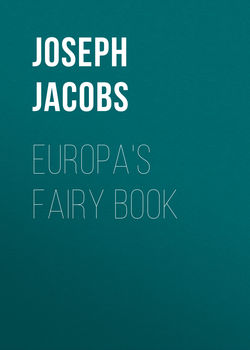Europa's Fairy Book

Реклама. ООО «ЛитРес», ИНН: 7719571260.
Оглавление
Joseph Jacobs. Europa's Fairy Book
PREFACE
THE CINDER-MAID
ALL CHANGE
THE KING OF THE FISHES
SCISSORS
BEAUTY AND THE BEAST
REYNARD AND BRUIN
THE DANCING WATER, THE SINGING APPLE, AND THE SPEAKING BIRD
THE LANGUAGE OF ANIMALS
THE THREE SOLDIERS
A DOZEN AT A BLOW
THE EARL OF CATTENBOROUGH
THE SWAN MAIDENS
ANDROCLES AND THE LION
DAY-DREAMING
KEEP COOL
THE MASTER THIEF
THE UNSEEN BRIDEGROOM
THE MASTER-MAID
A VISITOR FROM PARADISE
INSIDE AGAIN
JOHN THE TRUE
JOHNNIE AND GRIZZLE
THE CLEVER LASS
THUMBKIN
SNOWWHITE
INTRODUCTION TO NOTES
I. CINDER-MAID
II. ALL CHANGE
III. KING OF THE FISHES
IV. SCISSORS
V. BEAUTY AND THE BEAST
VI. REYNARD AND BRUIN
VII. DANCING WATER
VIII. LANGUAGE OF ANIMALS
IX. THE THREE SOLDIERS
X. DOZEN AT ONE BLOW
XI. EARL OF CATTENBOROUGH
XII. THE SWAN MAIDENS
XIII. ANDROCLES AND THE LION
XIV. DAY DREAMING
XV. KEEP COOL
XVI. THE MASTER THIEF
XVII. THE UNSEEN BRIDEGROOM
XVIII. THE MASTER-MAID
XIX. A VISITOR FROM PARADISE
XX. INSIDE AGAIN
XXI. JOHN THE TRUE
XXII. JOHNNIE AND GRIZZLE
XXIII. CLEVER LASS
XXIV. THUMBKIN
XXV. SNOWWHITE
LIST OF INCIDENTS
Отрывок из книги
Ever since—almost exactly a hundred years ago—the Grimms produced their Fairy Tale Book, folk-lorists have been engaged in making similar collections for all the other countries of Europe, outside Germany, till there is scarcely a nook or a corner in the whole continent that has not been ransacked for these products of the popular fancy. The Grimms themselves and most of their followers have pointed out the similarity or, one might even say, the identity of plot and incident of many of these tales throughout the European Folk-Lore field. Von Hahn, when collecting the Greek and Albanian Fairy Tales in 1864, brought together these common "formulæ" of the European Folk-Tale. These were supplemented by Mr. S. Baring-Gould in 1868, and I myself in 1892 contributed an even fuller list to the Hand Book of Folk-Lore. Most, if not all of these formulæ, have been found in all the countries of Europe where folk-tales have been collected. In 1893 Miss M. Roalfe Cox brought together, in a volume of the Folk-Lore Society, no less than 345 variants of "Cinderella" and kindred stories showing how widespread this particular formula was throughout Europe and how substantially identical the various incidents as reproduced in each particular country.
It has occurred to me that it would be of great interest and, for folk-lore purposes, of no little importance, to bring together these common Folk-Tales of Europe, retold in such a way as to bring out the original form from which all the variants were derived. I am, of course, aware of the difficulty and hazardous nature of such a proceeding; yet it is fundamentally the same as that by which scholars are accustomed to restore the Ur-text from the variants of different families of MSS. and still more similar to the process by which Higher Critics attempt to restore the original narratives of Holy Writ. Every one who has had to tell fairy tales to children will appreciate the conservative tendencies of the child mind; every time you vary an incident the children will cry out, "That was not the way you told us before." The Folk-Tale collections can therefore be assumed to retain the original readings with as much fidelity as most MSS. That there was such an original rendering eminating from a single folk artist no serious student of Miss Cox's volume can well doubt. When one finds practically the same "tags" of verse in such different dialects as Danish and Romaic, German and Italian, one cannot imagine that these sprang up independently in Denmark, Greece, Germany, and Florence. The same phenomenon is shown in another field of Folk-Lore where, as the late Mr. Newell showed, the same rhymes are used to brighten up the same children's games in Barcelona and in Boston; one cannot imagine them springing up independently in both places. So, too, when the same incidents of a fairy tale follow in the same artistic concatenation in Scotland, and in Sicily, in Brittany, and in Albania, one cannot but assume that the original form of the story was hit upon by one definite literary artist among the folk. What I have attempted to do in this book is to restore the original form, which by a sort of international selection has spread throughout all the European folks.
.....
You can imagine how excited the sisters were when they came home and told Cinder-Maid all about it, how that the beautiful lady had come in a golden coach in a dress like the sea, with golden shoes, and how all had disappeared at midnight except the golden shoe. "Ah, wouldn't you have liked to have been there?" said they.
Now when the Prince found out that he could not keep his lady-love nor trace where she had gone he spoke to his father and showed him the golden shoe, and told him that he would never marry any one but the maiden who could wear that shoe. So the King, his father, ordered the herald to take round the golden shoe upon a velvet cushion and to go to every four corners where two streets met and sound the trumpet and call out: "O yes, O yes, O yes, be it known unto you all that whatsoever lady of noble birth can fit this shoe upon her foot shall become the bride of his Highness the Prince and our future Queen. God save the King."
.....